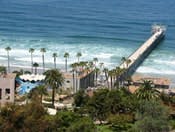The city of San Diego will spend approximately $1 billion over the next six years to make improvements to its sewer system under a comprehensive settlement filed today by the Justice Department and the U.S. Environmental Protection Agency.
The consent decree filed in U.S. District Court for the Southern District of California by the United States, along with co-plaintiffs Surfrider Foundation and San Diego Baykeeper, is the third and final settlement that addresses current violations in the city’s sewer system. The city must continue to undertake capital projects and perform operations and maintenance through 2013 to prevent future spills of raw sewage from San Diego’s system.
“This settlement will ensure that the city of San Diego will continue upgrades and repairs of its sewer system in order to comply with the Clean Water Act,” said acting assistant attorney general Ronald J. Tenpas. “We are pleased that we have reached a resolution to these matters, and that the city has agreed to make the necessary improvements to reduce untreated sewer discharges.”
“San Diego will spend over $1 billion to improve its aging sewer system and prevent future spills of raw, untreated sewage into local streams, the ocean, and city streets,” said Granta Nakayama, assistant administrator for Enforcement and Compliance Assurance. “This significant action creates a straightforward path to address sewer overflows and provides a safer recreational environment for the San Diego area.”
San Diego’s Municipal Wastewater Collection System collects wastewater from approximately 1.2 million residents over 330 square miles. The system has an estimated 2,800 miles of sewer lines and 84 pumping stations.
In 2000, there was an average of one spill per day from San Diego's collection system. In 2002, the EPA issued an administrative order requiring the city of San Diego to address sewer collection system maintenance, repair and replacement issues. In June 2003 the Department of Justice filed a complaint on behalf of the EPA seeking a long term court-sanctioned resolution to the problems, joining environmental groups who had already filed a Clean Water Act citizens’ lawsuit against the city, resulting in two partial consent decrees, issued in 2005 and 2006.
Since the EPA’s 2002 enforcement action, San Diego has reduced the number of spills by more than 75 percent and has largely eliminated large volume spills that plagued the city.
San Diego must also complete a number of capital projects to repair or replace the aging sewer system. Among the projects, the city is required to repair, replace or rehabilitate 250 miles of pipeline by 2013. It has already repaired or replaced 200 miles of pipeline under earlier settlements entered into in 2005 and 2006. The city will also upgrade and repair a number of pump stations in the system and secure all 5,800 manhole covers throughout the city. Further, the city will implement a program to educate residents of the Fats, Oils, and Grease Blockage Control Program, and conduct a sewer capacity assessment.
The state of California has penalized San Diego for past sewage spills. The California Regional Water Quality Control Board, San Diego region took three enforcement actions against San Diego for a combined total of $6.2 million in penalties with $4.1 million going toward local environmental improvement and monitoring projects.
Source: EPA


